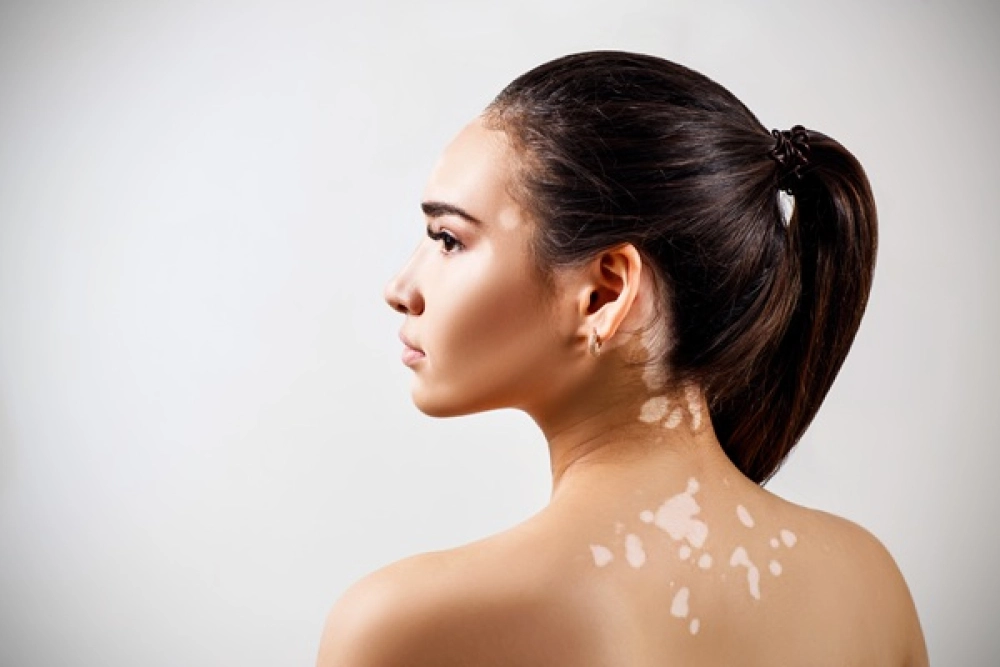 Vitiligo
Vitiligo
Vitiligo, also known as white spot disease, is a chronic skin condition characterized by the loss of pigment-producing cells (melanocytes), resulting in sharply defined white patches on the skin. While the exact cause remains unclear, it is believed that an immune system dysfunction and increased oxidative stress lead to the destruction of these pigment cells.
Vitiligo affects all skin types but can be particularly distressing in individuals with darker skin, as the contrast between the affected and unaffected areas is more pronounced. Vitiligo is not a rare condition—about 1–2% of the global population is affected. Well-known figures such as pop icon Michael Jackson and model Winnie Harlow have publicly lived with this condition.
Photo: © Dmitrii Kotin – stock.adobe.com
- What are the symptoms of Vitiligo?
- What causes Vitiligo?
- What types of Vitiligo are there?
- How is Vitiligo diagnosed?
- What are the treatment options?
- Is Vitiligo contagious?
- How does Vitiligo affect quality of life?
What are the symptoms of Vitiligo?
The primary symptom is white or light-colored patches on the skin, which can vary in size. These patches often appear symmetrically and may spread over time. In early stages, mild itching or redness may occur.
What causes Vitiligo?
The exact causes of vitiligo are not fully understood. However, it is believed that a dysfunction of the immune system leads to the destruction of melanocytes. Genetic factors and other autoimmune diseases—such as thyroid disorders—may also play a role.
One contributing factor is oxidative stress: a condition where the body produces more free radicals than it can neutralize. These free radicals are aggressive oxygen compounds that can damage cells—similar to how metal rusts. Normally, the body’s defense systems protect against this, but in people with vitiligo, this defense in the skin may be impaired.
As a result, pigment cells are damaged and may die. In addition, oxidative stress may further disrupt the immune system, causing it to attack its own melanocytes—thus accelerating the progression of the condition.
What types of Vitiligo are there?
Vitiligo appears in several forms, which differ based on the distribution of pigment loss:
Non-segmental vitiligo (NSV): The most common form, with symmetrical white patches—e.g., on both hands or knees. It tends to progress in phases over time.
Segmental vitiligo (SV): A rarer form, often appearing on one side of the body in a clearly defined area. It typically begins in childhood or adolescence and tends to remain stable.
Focal vitiligo: Isolated white patches without a symmetrical pattern. This form often remains unchanged for extended periods.
Mixed vitiligo: A combination of segmental and non-segmental patterns.
Vitiligo universalis: An extremely rare, advanced form involving complete or nearly complete loss of skin pigment.
How is Vitiligo diagnosed?
Diagnosis is usually made through a clinical examination. A dermatologist may use a special lamp (Wood’s light) to highlight affected areas and confirm the diagnosis. In rare cases, a skin biopsy may be needed.
We also conduct blood tests as part of the diagnostic process to identify associated conditions, such as thyroid disorders, which frequently co-occur with vitiligo. We check for nutritional deficiencies as well, since they can negatively affect the disease—allowing us to recommend targeted supplementation when necessary.
What are the treatment options?
Although vitiligo is not curable, several therapies can slow its progression or restore pigmentation. These include topical medications, light therapy (phototherapy), and, in some cases, surgical treatments. The best approach varies by individual and should be discussed with a dermatologist.
Encouragingly, after many years without innovation, several new medications and therapies have recently become available—and even more are close to approval.
At our center near Vienna’s main train station, we offer more than just medical therapy. As a specialist facility, we continually update our knowledge to provide the most advanced and personalized treatment plans. In addition, we offer complementary options such as nutritional supplements with proven benefits. Our medically trained aestheticians can also advise you on camouflage makeup to help improve the skin’s appearance.
Please feel free to schedule a consultation with one of our doctors to discuss your options.
Is Vitiligo contagious?
No. Vitiligo is not contagious. It is an autoimmune condition and cannot be transmitted through contact.
How does Vitiligo affect quality of life?
Vitiligo can have a significant emotional and psychological impact—especially when the white patches appear on visible areas such as the face or hands. Seeking support and, if needed, professional counseling can help manage the emotional aspects of living with vitiligo.
It is important to note: vitiligo is not merely a “cosmetic issue.” Treatment is indicated if a patient’s quality of life is affected or to help prevent further progression of the condition.
For more information or a personalized consultation, we invite you to visit our practice in Vienna.



